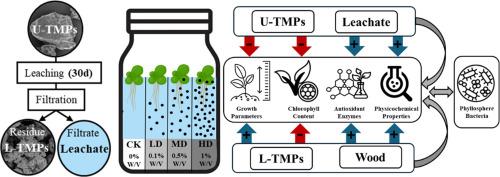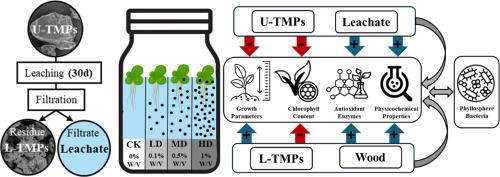轮胎微塑料及其渗滤液对多根螺旋体和根球菌的双重急性影响
IF 12.4
1区 环境科学与生态学
Q1 ENGINEERING, ENVIRONMENTAL
引用次数: 0
摘要
轮胎微塑料(TMPs)主要通过径流进入水生环境,对水生生态系统构成潜在威胁,对全球塑料污染做出了重大贡献。除了颗粒本身,挥发性有机污染物产生的渗滤液进一步加剧了环境风险。尽管人们对塑料污染的关注日益增加,但tmp及其渗滤液对水生系统的影响在很大程度上仍未得到充分研究。为了解决这一空白,我们系统地评估了TMPs及其渗出液(0 ~ 1% w/v)如何影响水生大型植物模式浮萍(Spirodela polyrhiza)的生长、物理化学反应和层球细菌群落,并以天然颗粒木材为对照。研究结果表明,释放的TMPs和渗滤液均对多根葡萄的生长产生不利影响,并抑制光合色素的产生。未释放的TMPs和渗滤液暴露会引发氧化应激,这可以通过抗氧化酶活性和脂质过氧化水平的改变来证明。值得注意的是,与木颗粒相比,浸出的TMPs促进了植物的生长,这表明它们在当前浓度下可能为水生植物创造有利条件。不同处理层球细菌组成差异显著;TMPs暴露增加了水族细菌的丰度,但诱导了土杆菌的剂量依赖性减少。此外,暴露于TMPs大大改变了层状圈细菌群落的代谢过程,特别是影响了与营养代谢、外源降解和应激适应相关的关键微生物功能。植物特性与层球细菌群落之间的相关性因处理的不同而不同,这表明TMPs的双重作用可能归因于渗滤液中的溶解物质。本研究阐明了TMP、水生大型植物和层球微生物之间复杂的相互作用,强调了对淡水环境中TMP污染的生态后果进行进一步研究的必要性。本文章由计算机程序翻译,如有差异,请以英文原文为准。


Dual acute effects of tire microplastics and their leachates on Spirodela polyrhiza and phyllosphere bacteria
Tire microplastics (TMPs) significantly contribute to global plastic pollution, entering aquatic environments primarily through runoff, where they pose potential threats to aquatic ecosystems. Beyond the particles themselves, TMPs-derived leachates further exacerbate environmental risks. Despite growing concern over plastic pollution, the influences of TMPs and their leachates on aquatic systems remain largely understudied. To address this gap, we systematically evaluated how TMPs and their leachate (0∼1 % w/v) affect the growth, physiochemical responses, and phyllosphere bacterial community of model aquatic macrophyte duckweed (Spirodela polyrhiza), using natural particulate wood as a control. Our findings reveal that both unleached TMPs and leachates exerted detrimental effects on the growth of S. polyrhiza and inhibited the production of photosynthetic pigments. Unleached TMPs and leachate exposures triggered oxidative stress, as evidenced by alterations in antioxidant enzyme activities and lipid peroxidation levels. Notably, leached TMPs enhanced plant growth comparably to wood particulates, suggesting their potential to generate favorable conditions for aquatic plants at prevailing concentrations. Phyllosphere bacterial composition exhibited significant differences among treatments; TMPs exposures increased Aquabacterium abundance but induced a dose-dependent decrease in Pedobacter. Also, exposure to TMPs substantially altered the metabolic processes within phyllosphere bacterial communities, particularly affecting key microbial functions linked to nutrient metabolism, xenobiotic degradation, and stress adaptation. The correlations between plant properties and phyllosphere bacterial communities varied depending on the treatments, suggesting that the dual effects of TMPs may be attributed to the dissolved substances in the leachates. This study elucidates the complex interactions among TMPs, aquatic macrophytes, and phyllosphere microbiomes, highlighting the need for further investigation into the ecological consequences of TMP pollution in freshwater environments.
求助全文
通过发布文献求助,成功后即可免费获取论文全文。
去求助
来源期刊

Water Research
环境科学-工程:环境
CiteScore
20.80
自引率
9.40%
发文量
1307
审稿时长
38 days
期刊介绍:
Water Research, along with its open access companion journal Water Research X, serves as a platform for publishing original research papers covering various aspects of the science and technology related to the anthropogenic water cycle, water quality, and its management worldwide. The audience targeted by the journal comprises biologists, chemical engineers, chemists, civil engineers, environmental engineers, limnologists, and microbiologists. The scope of the journal include:
•Treatment processes for water and wastewaters (municipal, agricultural, industrial, and on-site treatment), including resource recovery and residuals management;
•Urban hydrology including sewer systems, stormwater management, and green infrastructure;
•Drinking water treatment and distribution;
•Potable and non-potable water reuse;
•Sanitation, public health, and risk assessment;
•Anaerobic digestion, solid and hazardous waste management, including source characterization and the effects and control of leachates and gaseous emissions;
•Contaminants (chemical, microbial, anthropogenic particles such as nanoparticles or microplastics) and related water quality sensing, monitoring, fate, and assessment;
•Anthropogenic impacts on inland, tidal, coastal and urban waters, focusing on surface and ground waters, and point and non-point sources of pollution;
•Environmental restoration, linked to surface water, groundwater and groundwater remediation;
•Analysis of the interfaces between sediments and water, and between water and atmosphere, focusing specifically on anthropogenic impacts;
•Mathematical modelling, systems analysis, machine learning, and beneficial use of big data related to the anthropogenic water cycle;
•Socio-economic, policy, and regulations studies.
 求助内容:
求助内容: 应助结果提醒方式:
应助结果提醒方式:


